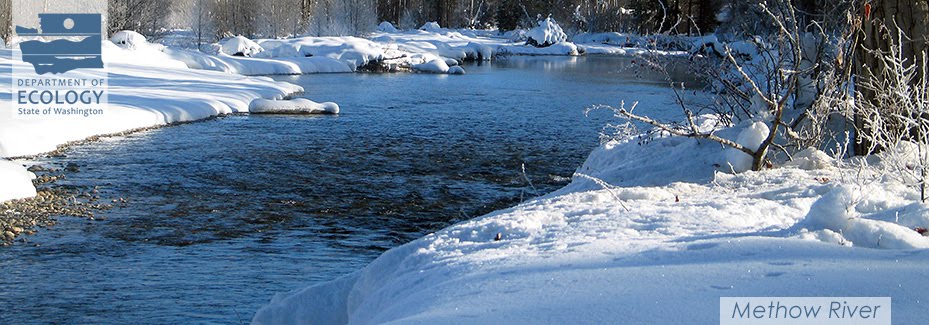
Environmental investigators Glen Vedera and Julie Wartes with Science Applications International Corporation, under a Washington Department of Ecology contract, collect stormwater samples in the North Boeing Field area of south Seattle in January 2010.
Detective work takes patience and persistence.
Over the fall and winter months we’ve needed plenty of both for the Department of Ecology’s investigation in the North Boeing Field area to locate and control contamination that enters the nearby Duwamish Waterway.A rainy forecast means more opportunities. This is when we gather stormwater and sediment samples from drain lines.
A sampling crew from Science Applications International Corporation (SAIC) works under a contract with Ecology. The study is part of an agreement between Ecology, the City of Seattle, King County, and the Boeing Company to investigate and propose solutions for soil, stormwater, and groundwater contamination in the North Boeing Field/Georgetown Steam Plant area of south Seattle.
EPA and Ecology have agreed to accelerate investigation.
The U.S. Environmental Protection Agency (EPA) plans for contaminated sediment at the bottom of Slip 4, a nearby inlet of the Duwamish Waterway, to be cleaned up by fall of 2011. EPA and Ecology have agreed to accelerate investigation of pollutant sources on the 137-acre North Boeing Field/Georgetown Steam Plant site to prevent re-contamination of the inlet to meet the cleanup target date.Polychlorinated biphenyls (PCBs) and other pollutants have been found in storm drains that empty to Slip 4 from the site. PCBs were commonly added to oil used in electrical transformers. They were banned in the 1970s after scientists found that the chemical was harmful to people and http://www.atsdr.cdc.gov/tfacts17.html#bookmark03for many years if leaked or spilled.
The current work is part of a comprehensive site investigation supervised by Ecology and conducted by SAIC. The three property owners have agreed to jointly pay the cost of this sampling and analysis. The study area includes northern portions of King County International Airport (Boeing Field) – property owned by King County and currently leased by Boeing – and the city-owned Georgetown Steam Plant site at the airport’s north end.
The three parties have conducted several cleanup and storm-drain improvement projects over the past 25 years, all aimed at cleaning up soil and groundwater contamination from past industrial activities. These included replacement of some pavement joint seals at the airport that contained PCBs and the cleanup and replacement of a contaminated drainage channel called the Georgetown Steam Plant flume. Additional joint-seals replacement and other cleanup projects may be necessary, because PCBs and other contaminants continue to appear in storm drain sediments.
A five-mile reach of the river upstream of Harbor Island is the federal Lower Duwamish Superfund cleanup site, jointly administered by the EPA and Ecology. Slip 4 is part of that larger sediment cleanup effort.
The Duwamish flows to Puget Sound.
Cleanup of the waterway is a significant part of Ecology’s effort to reduce and prevent toxic threats to the environment and to support the Governor’s Puget Sound Initiative – a cooperative effort among state, local, federal and tribal governments, businesses, and organizations to protect and restore Washington’s inland marine waters.Like all detective work, environment investigations involve sifting for clues. AIC’s sampling work provides new “evidence” to help us identify lingering sources of PCB contamination. This could lead to special environmental cleanup projects – called Interim Actions in Washington’s toxics cleanup law – to prevent PCB releases from re-contaminating Slip 4. Other solutions could include construction of a treatment system to reduce PCB concentrations in stormwater discharges.
We’re also making use of the data to create a computer model to help us understand how much protection Slip 4 will need after the 2011 cleanup of its sediments. We’ll use the model to set limits on PCB concentrations in the drainage system sediments in order to prevent the inlet’s recontamination.
Cleanups on land that prevent contamination of Duwamish sediments are called Source Control. Ecology coordinates most of the Source Control investigations and cleanups in the Lower Duwamish, including this one.
There are more planned cleanup zones in the Lower Duwamish Waterway, and more Source Control areas that drain to them. Slip 4 and North Boeing Field/Georgetown Steam Plant drainage basin help illustrate the magnitude of the challenge – and potential for achievement – that the overall Lower Duwamish cleanup presents for the governments, property owners, and communities that have stakes in this undertaking.
For more information:
North Boeing Field/Georgetown Steam Plant area: http://www.ecy.wa.gov/programs/tcp/sites/lower_duwamish/sites/nBoeingGeorgeTnStmPlant/nBoeingGeorgetown.htmLower Duwamish Superfund site: http://www.ecy.wa.gov/programs/tcp/sites/lower_duwamish/lower_duwamish_hp.html

No comments:
Post a Comment